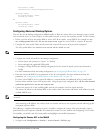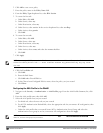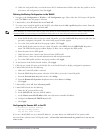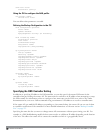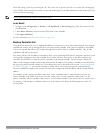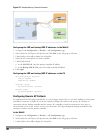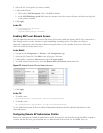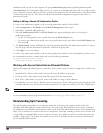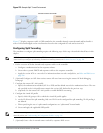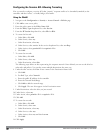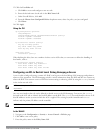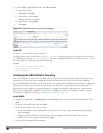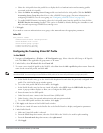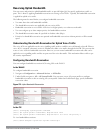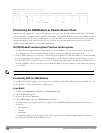
Figure 173: Sample Split Tunnel Environment
Figure 173 displays corporate traffic is GRE tunneled to the controller through a trusted tunnel and local traffic is
source NATed and bridged on the wired interface based on the configured user role and session ACL.
Configuring Split Tunneling
The procedure to configure split tunneling requires the following steps. Each step is described in detail later in this
chapter.
NOTE: The split tunneling feature requires the PEFNG license. If you do not have the PEFNG license on your controller, you must
install it before you configure split tunneling. For details on installing licenses, see "Software Licenses" on page 100.
1. Define a session ACL that forwards only corporate traffic to the controller.
a. Configure a netdestination for the corporate subnets.
b. Create rules to permit DHCP and corporate traffic to the corporate controller.
c. Apply the session ACL to a user role. For information about user roles and policies, see Roles and Policies on
page 296.
2. (Optional) Configure an ACL that restricts remote AP users from accessing the remote AP local debugging
homepage.
3. Configure the remote AP’s AAA profile.
a. Specify the authentication method (802.1x or PSK) and the default user role for authenticated users. The user
role specified in the AAA profile must contain the session ACL defined in the previous step.
b. (Optional) Use the remote AP’s AAA profile to enable RADIUS accounting.
4. Configure the virtual AP profile:
a. Specify which AP group or AP to which the virtual AP profile applies.
b. set the VLAN used for split tunneling. Only one VLAN can be configured for split tunneling; VLAN pooling is
not allowed.
c. When specifying the use of a split tunnel configuration, use “split-tunnel” forward mode.
d. Create and apply the applicable SSID profile.
NOTE: When creating a new virtual AP profile In the WebUI, you can also configure the SSID at the same time. For information
about AP profiles, see "Understanding AP Configuration Profiles" on page 396.
5. (Optional) Create a list of network names resolved by corporate DNS servers.
DellPowerConnectW-SeriesArubaOS6.2 | User Guide RemoteAccessPoints | 536



